Case Study On Institutional Affiliation
VerifiedAdded on 2022/09/28
|5
|1068
|32
AI Summary
Contribute Materials
Your contribution can guide someone’s learning journey. Share your
documents today.
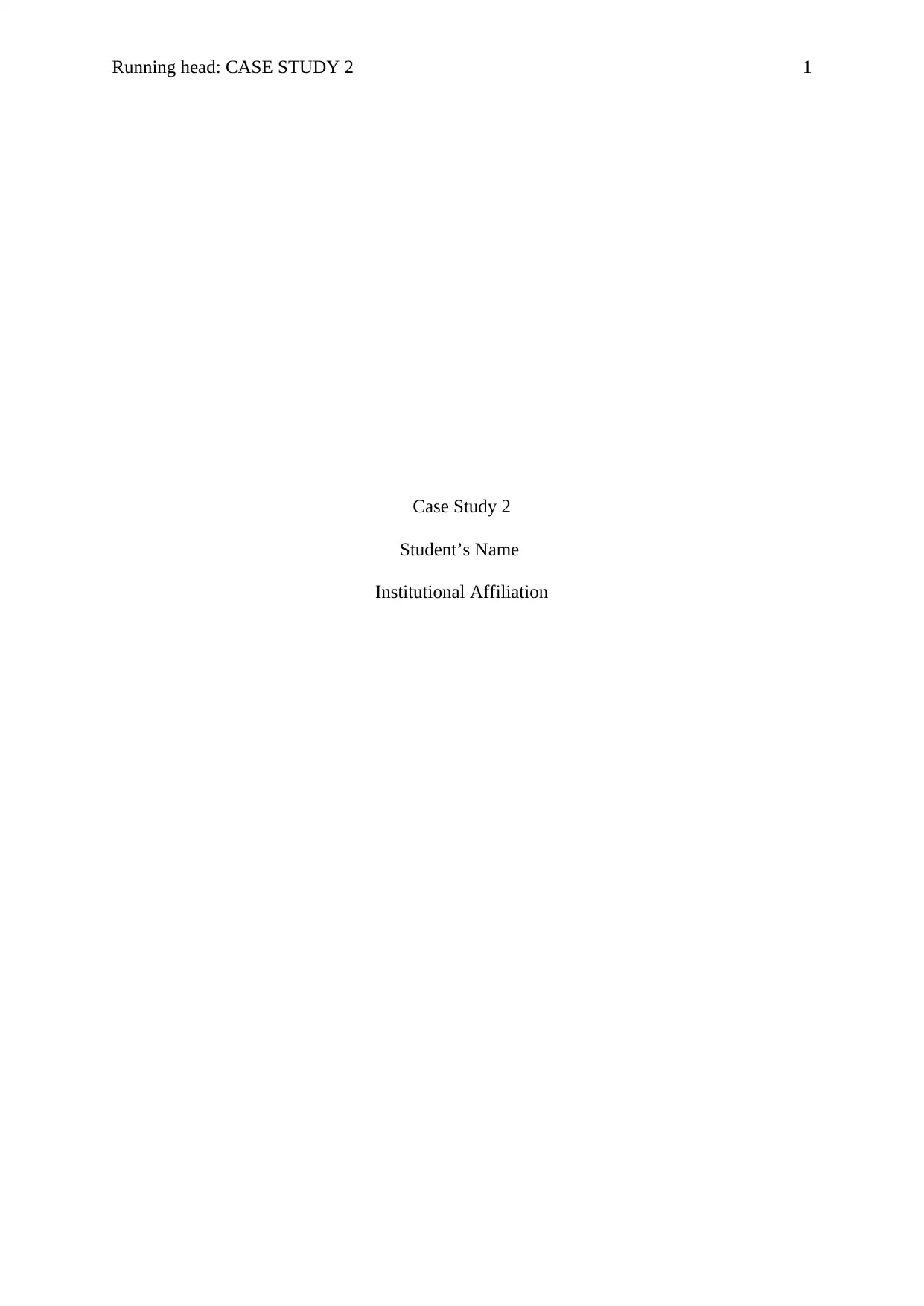
Running head: CASE STUDY 2 1
Case Study 2
Student’s Name
Institutional Affiliation
Case Study 2
Student’s Name
Institutional Affiliation
Secure Best Marks with AI Grader
Need help grading? Try our AI Grader for instant feedback on your assignments.
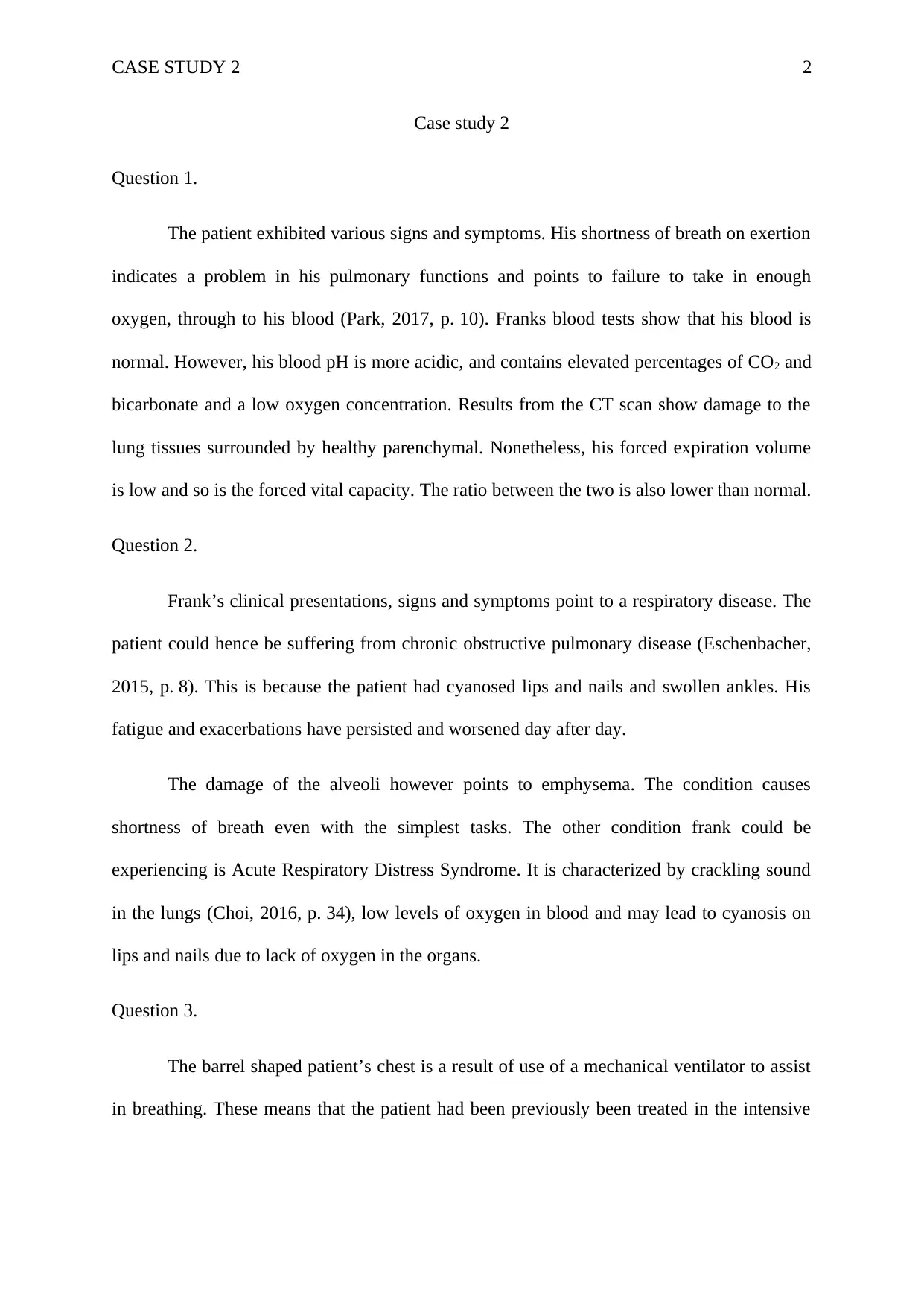
CASE STUDY 2 2
Case study 2
Question 1.
The patient exhibited various signs and symptoms. His shortness of breath on exertion
indicates a problem in his pulmonary functions and points to failure to take in enough
oxygen, through to his blood (Park, 2017, p. 10). Franks blood tests show that his blood is
normal. However, his blood pH is more acidic, and contains elevated percentages of CO2 and
bicarbonate and a low oxygen concentration. Results from the CT scan show damage to the
lung tissues surrounded by healthy parenchymal. Nonetheless, his forced expiration volume
is low and so is the forced vital capacity. The ratio between the two is also lower than normal.
Question 2.
Frank’s clinical presentations, signs and symptoms point to a respiratory disease. The
patient could hence be suffering from chronic obstructive pulmonary disease (Eschenbacher,
2015, p. 8). This is because the patient had cyanosed lips and nails and swollen ankles. His
fatigue and exacerbations have persisted and worsened day after day.
The damage of the alveoli however points to emphysema. The condition causes
shortness of breath even with the simplest tasks. The other condition frank could be
experiencing is Acute Respiratory Distress Syndrome. It is characterized by crackling sound
in the lungs (Choi, 2016, p. 34), low levels of oxygen in blood and may lead to cyanosis on
lips and nails due to lack of oxygen in the organs.
Question 3.
The barrel shaped patient’s chest is a result of use of a mechanical ventilator to assist
in breathing. These means that the patient had been previously been treated in the intensive
Case study 2
Question 1.
The patient exhibited various signs and symptoms. His shortness of breath on exertion
indicates a problem in his pulmonary functions and points to failure to take in enough
oxygen, through to his blood (Park, 2017, p. 10). Franks blood tests show that his blood is
normal. However, his blood pH is more acidic, and contains elevated percentages of CO2 and
bicarbonate and a low oxygen concentration. Results from the CT scan show damage to the
lung tissues surrounded by healthy parenchymal. Nonetheless, his forced expiration volume
is low and so is the forced vital capacity. The ratio between the two is also lower than normal.
Question 2.
Frank’s clinical presentations, signs and symptoms point to a respiratory disease. The
patient could hence be suffering from chronic obstructive pulmonary disease (Eschenbacher,
2015, p. 8). This is because the patient had cyanosed lips and nails and swollen ankles. His
fatigue and exacerbations have persisted and worsened day after day.
The damage of the alveoli however points to emphysema. The condition causes
shortness of breath even with the simplest tasks. The other condition frank could be
experiencing is Acute Respiratory Distress Syndrome. It is characterized by crackling sound
in the lungs (Choi, 2016, p. 34), low levels of oxygen in blood and may lead to cyanosis on
lips and nails due to lack of oxygen in the organs.
Question 3.
The barrel shaped patient’s chest is a result of use of a mechanical ventilator to assist
in breathing. These means that the patient had been previously been treated in the intensive
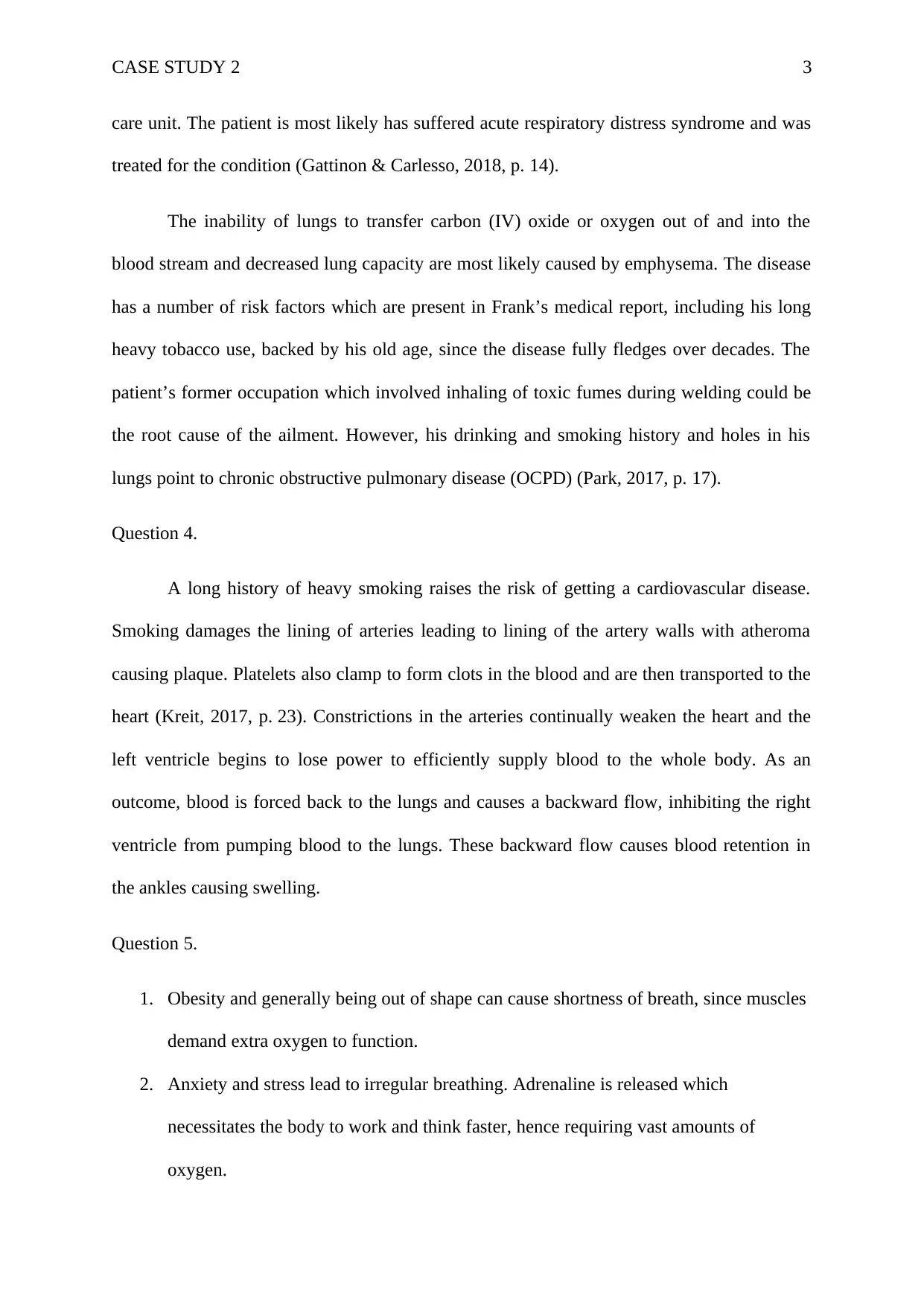
CASE STUDY 2 3
care unit. The patient is most likely has suffered acute respiratory distress syndrome and was
treated for the condition (Gattinon & Carlesso, 2018, p. 14).
The inability of lungs to transfer carbon (IV) oxide or oxygen out of and into the
blood stream and decreased lung capacity are most likely caused by emphysema. The disease
has a number of risk factors which are present in Frank’s medical report, including his long
heavy tobacco use, backed by his old age, since the disease fully fledges over decades. The
patient’s former occupation which involved inhaling of toxic fumes during welding could be
the root cause of the ailment. However, his drinking and smoking history and holes in his
lungs point to chronic obstructive pulmonary disease (OCPD) (Park, 2017, p. 17).
Question 4.
A long history of heavy smoking raises the risk of getting a cardiovascular disease.
Smoking damages the lining of arteries leading to lining of the artery walls with atheroma
causing plaque. Platelets also clamp to form clots in the blood and are then transported to the
heart (Kreit, 2017, p. 23). Constrictions in the arteries continually weaken the heart and the
left ventricle begins to lose power to efficiently supply blood to the whole body. As an
outcome, blood is forced back to the lungs and causes a backward flow, inhibiting the right
ventricle from pumping blood to the lungs. These backward flow causes blood retention in
the ankles causing swelling.
Question 5.
1. Obesity and generally being out of shape can cause shortness of breath, since muscles
demand extra oxygen to function.
2. Anxiety and stress lead to irregular breathing. Adrenaline is released which
necessitates the body to work and think faster, hence requiring vast amounts of
oxygen.
care unit. The patient is most likely has suffered acute respiratory distress syndrome and was
treated for the condition (Gattinon & Carlesso, 2018, p. 14).
The inability of lungs to transfer carbon (IV) oxide or oxygen out of and into the
blood stream and decreased lung capacity are most likely caused by emphysema. The disease
has a number of risk factors which are present in Frank’s medical report, including his long
heavy tobacco use, backed by his old age, since the disease fully fledges over decades. The
patient’s former occupation which involved inhaling of toxic fumes during welding could be
the root cause of the ailment. However, his drinking and smoking history and holes in his
lungs point to chronic obstructive pulmonary disease (OCPD) (Park, 2017, p. 17).
Question 4.
A long history of heavy smoking raises the risk of getting a cardiovascular disease.
Smoking damages the lining of arteries leading to lining of the artery walls with atheroma
causing plaque. Platelets also clamp to form clots in the blood and are then transported to the
heart (Kreit, 2017, p. 23). Constrictions in the arteries continually weaken the heart and the
left ventricle begins to lose power to efficiently supply blood to the whole body. As an
outcome, blood is forced back to the lungs and causes a backward flow, inhibiting the right
ventricle from pumping blood to the lungs. These backward flow causes blood retention in
the ankles causing swelling.
Question 5.
1. Obesity and generally being out of shape can cause shortness of breath, since muscles
demand extra oxygen to function.
2. Anxiety and stress lead to irregular breathing. Adrenaline is released which
necessitates the body to work and think faster, hence requiring vast amounts of
oxygen.
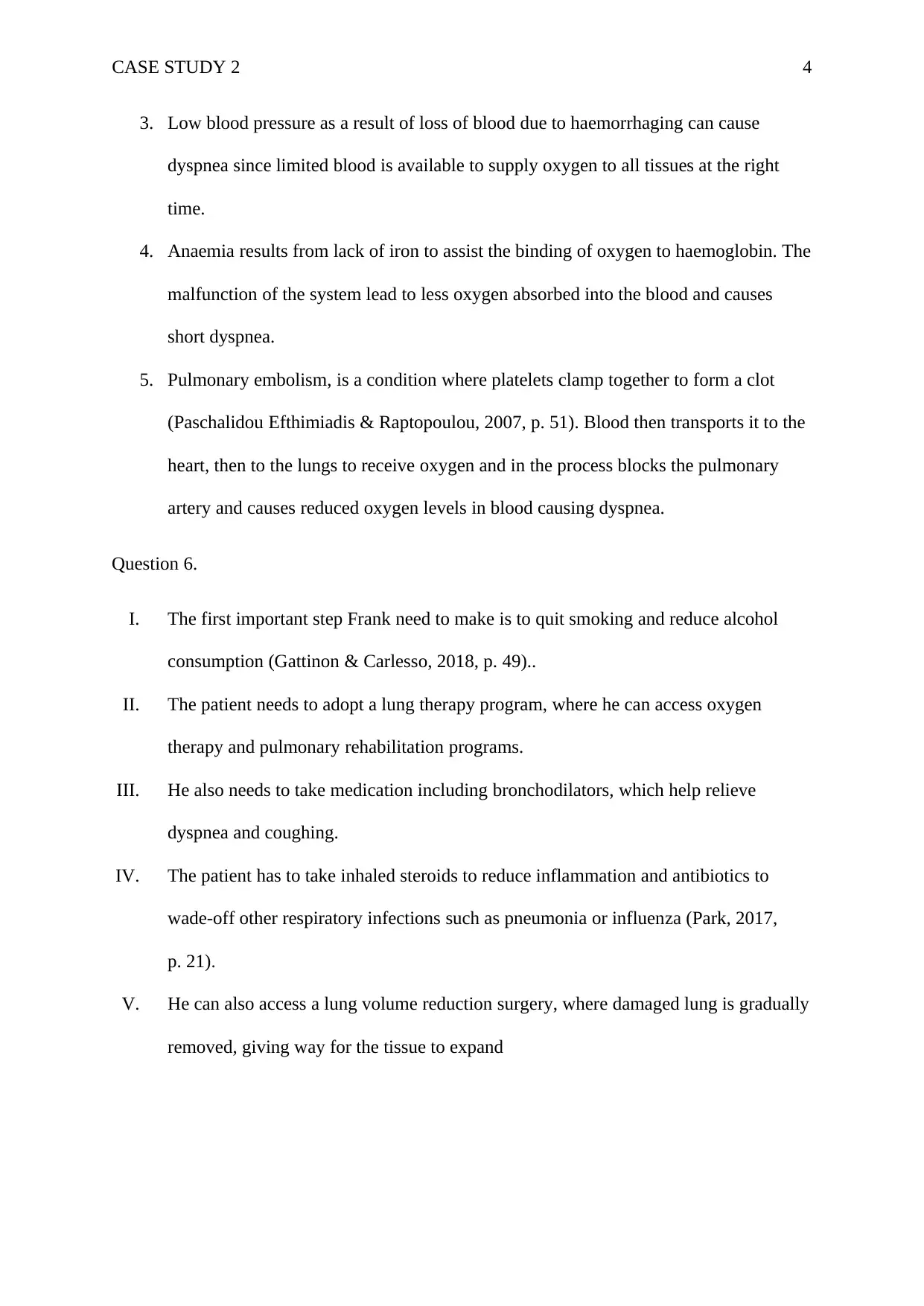
CASE STUDY 2 4
3. Low blood pressure as a result of loss of blood due to haemorrhaging can cause
dyspnea since limited blood is available to supply oxygen to all tissues at the right
time.
4. Anaemia results from lack of iron to assist the binding of oxygen to haemoglobin. The
malfunction of the system lead to less oxygen absorbed into the blood and causes
short dyspnea.
5. Pulmonary embolism, is a condition where platelets clamp together to form a clot
(Paschalidou Efthimiadis & Raptopoulou, 2007, p. 51). Blood then transports it to the
heart, then to the lungs to receive oxygen and in the process blocks the pulmonary
artery and causes reduced oxygen levels in blood causing dyspnea.
Question 6.
I. The first important step Frank need to make is to quit smoking and reduce alcohol
consumption (Gattinon & Carlesso, 2018, p. 49)..
II. The patient needs to adopt a lung therapy program, where he can access oxygen
therapy and pulmonary rehabilitation programs.
III. He also needs to take medication including bronchodilators, which help relieve
dyspnea and coughing.
IV. The patient has to take inhaled steroids to reduce inflammation and antibiotics to
wade-off other respiratory infections such as pneumonia or influenza (Park, 2017,
p. 21).
V. He can also access a lung volume reduction surgery, where damaged lung is gradually
removed, giving way for the tissue to expand
3. Low blood pressure as a result of loss of blood due to haemorrhaging can cause
dyspnea since limited blood is available to supply oxygen to all tissues at the right
time.
4. Anaemia results from lack of iron to assist the binding of oxygen to haemoglobin. The
malfunction of the system lead to less oxygen absorbed into the blood and causes
short dyspnea.
5. Pulmonary embolism, is a condition where platelets clamp together to form a clot
(Paschalidou Efthimiadis & Raptopoulou, 2007, p. 51). Blood then transports it to the
heart, then to the lungs to receive oxygen and in the process blocks the pulmonary
artery and causes reduced oxygen levels in blood causing dyspnea.
Question 6.
I. The first important step Frank need to make is to quit smoking and reduce alcohol
consumption (Gattinon & Carlesso, 2018, p. 49)..
II. The patient needs to adopt a lung therapy program, where he can access oxygen
therapy and pulmonary rehabilitation programs.
III. He also needs to take medication including bronchodilators, which help relieve
dyspnea and coughing.
IV. The patient has to take inhaled steroids to reduce inflammation and antibiotics to
wade-off other respiratory infections such as pneumonia or influenza (Park, 2017,
p. 21).
V. He can also access a lung volume reduction surgery, where damaged lung is gradually
removed, giving way for the tissue to expand
Secure Best Marks with AI Grader
Need help grading? Try our AI Grader for instant feedback on your assignments.
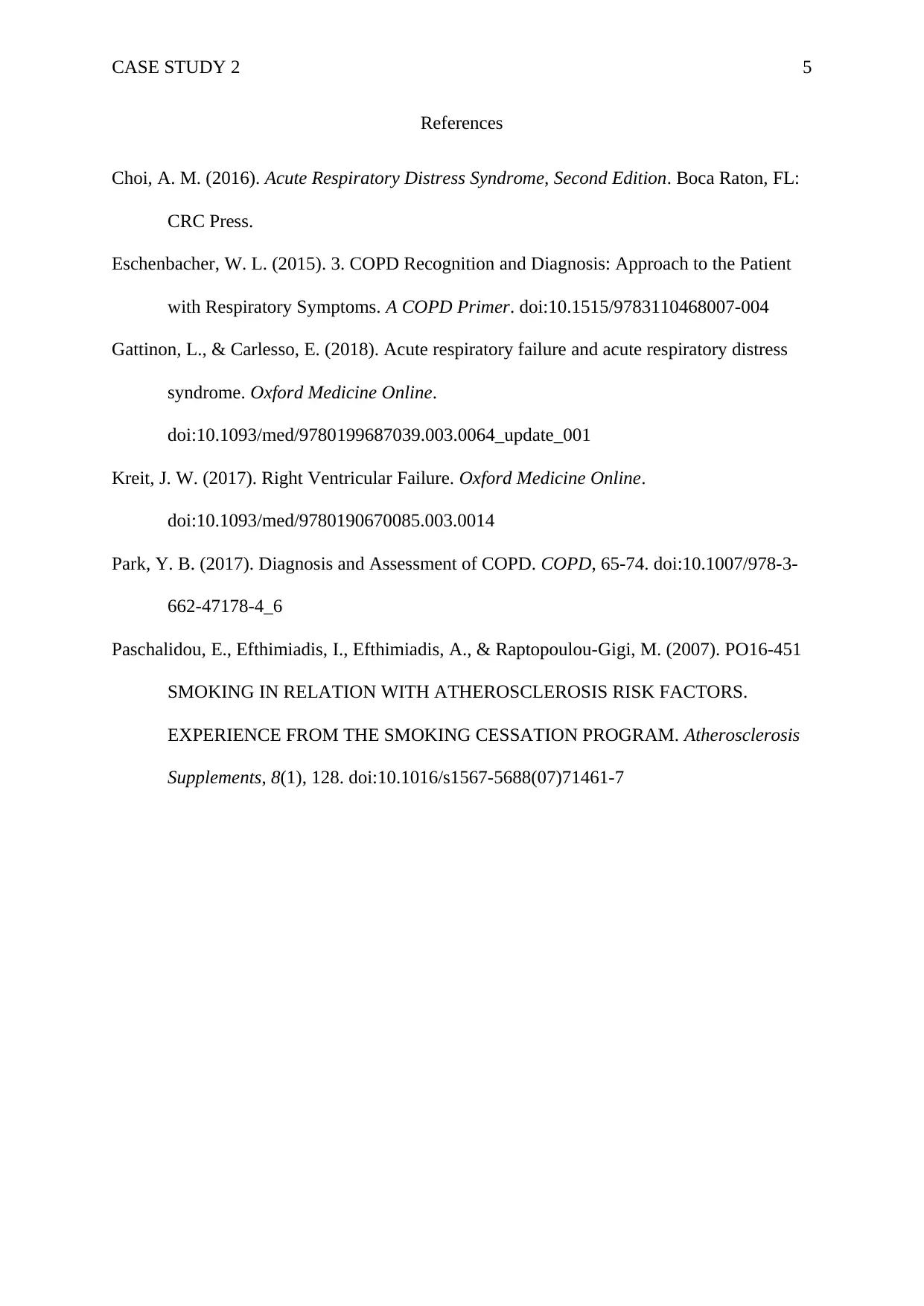
CASE STUDY 2 5
References
Choi, A. M. (2016). Acute Respiratory Distress Syndrome, Second Edition. Boca Raton, FL:
CRC Press.
Eschenbacher, W. L. (2015). 3. COPD Recognition and Diagnosis: Approach to the Patient
with Respiratory Symptoms. A COPD Primer. doi:10.1515/9783110468007-004
Gattinon, L., & Carlesso, E. (2018). Acute respiratory failure and acute respiratory distress
syndrome. Oxford Medicine Online.
doi:10.1093/med/9780199687039.003.0064_update_001
Kreit, J. W. (2017). Right Ventricular Failure. Oxford Medicine Online.
doi:10.1093/med/9780190670085.003.0014
Park, Y. B. (2017). Diagnosis and Assessment of COPD. COPD, 65-74. doi:10.1007/978-3-
662-47178-4_6
Paschalidou, E., Efthimiadis, I., Efthimiadis, A., & Raptopoulou-Gigi, M. (2007). PO16-451
SMOKING IN RELATION WITH ATHEROSCLEROSIS RISK FACTORS.
EXPERIENCE FROM THE SMOKING CESSATION PROGRAM. Atherosclerosis
Supplements, 8(1), 128. doi:10.1016/s1567-5688(07)71461-7
References
Choi, A. M. (2016). Acute Respiratory Distress Syndrome, Second Edition. Boca Raton, FL:
CRC Press.
Eschenbacher, W. L. (2015). 3. COPD Recognition and Diagnosis: Approach to the Patient
with Respiratory Symptoms. A COPD Primer. doi:10.1515/9783110468007-004
Gattinon, L., & Carlesso, E. (2018). Acute respiratory failure and acute respiratory distress
syndrome. Oxford Medicine Online.
doi:10.1093/med/9780199687039.003.0064_update_001
Kreit, J. W. (2017). Right Ventricular Failure. Oxford Medicine Online.
doi:10.1093/med/9780190670085.003.0014
Park, Y. B. (2017). Diagnosis and Assessment of COPD. COPD, 65-74. doi:10.1007/978-3-
662-47178-4_6
Paschalidou, E., Efthimiadis, I., Efthimiadis, A., & Raptopoulou-Gigi, M. (2007). PO16-451
SMOKING IN RELATION WITH ATHEROSCLEROSIS RISK FACTORS.
EXPERIENCE FROM THE SMOKING CESSATION PROGRAM. Atherosclerosis
Supplements, 8(1), 128. doi:10.1016/s1567-5688(07)71461-7
1 out of 5
Related Documents
Your All-in-One AI-Powered Toolkit for Academic Success.
+13062052269
info@desklib.com
Available 24*7 on WhatsApp / Email
![[object Object]](/_next/static/media/star-bottom.7253800d.svg)
Unlock your academic potential
© 2024 | Zucol Services PVT LTD | All rights reserved.



